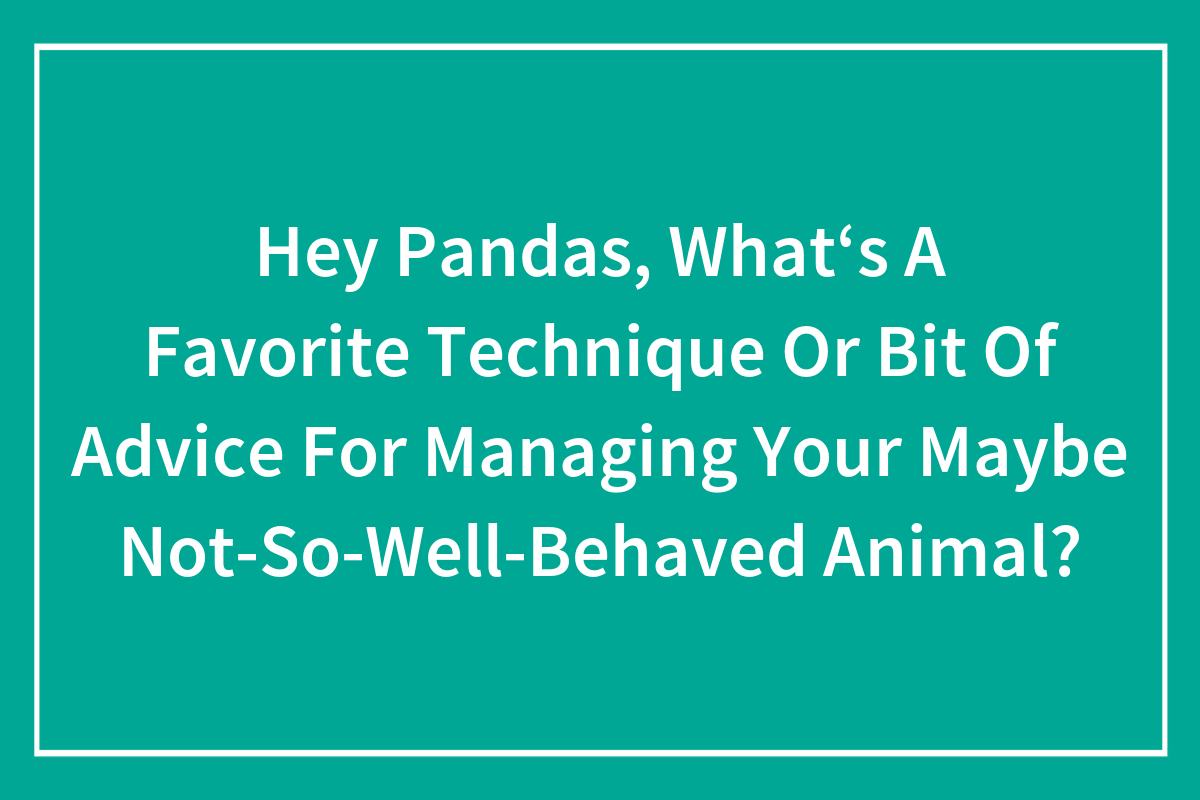
8submissions
Finished
Hey Pandas, What‘s A Favorite Technique Or Bit Of Advice For Managing Your Maybe Not-So-Well-Behaved Animal?
Our Australian Border Lab (not a real breed, just a mix with the neuroses of the herding breeds matched with the enthusiasm of a lab) has impulse control problems. That is understating it. All of her emotions and desires run at 100% all the time. But a technique I’ve figured out for her is just slowly counting to three. One… two… …THREE! Three is the release word, said excitedly, so she can go run, eat her food, etc. It makes her pause for just a moment, instead of maniacally diving into all her ventures.
It works well on things she doesn’t like, too. She hates being toweled off, so each foot, and then her belly, and then her back is dried for a count of three and then a treat. She looks forward to it now.
How about you?
This post may include affiliate links.
We found out when training our service dog that if you want a dog to stop something, don’t yell! It will seem to them like you are barking along with them. Instead find something else; we made a buzzing sound with our mouths. Worked like a charm. Another important thing is to reinforce good behavior. If they don’t feel like they do anything right, they’ll be more unruly.
There’s an old woman who walks a really reactive schnauzer in my neighborhood. He barks at all passing dogs, and in a loud, nasally voice she yells, “No! Nooo! Nooo!” She does absolutely nothing else to correct him, and he never stops barking for even a second. I know he thinks she’s just joining in the barking.
I'm a dog trainer so... I think over arching, my favorite technique is having expectations.
It's amazing to me how many people just have no expectations of their dogs. No matter how many times I try to tell them that they need to raise expectations because their dog is smart, their dog is capable so many are just comfortable expectating the bare minimum. By graduation you can always tell the people with expectations from the ones without.
With expectations: they say it once, the dog does it quickly. The dog does it too the absolute best of its ability. The dog is always watching the owner for signals/ commands. The dog is confident and while it may struggle with a few little things you can see the owner working through it.
Without expectations: "Spot sit... spot... sit... sit spot. Spot sit... spot I said sIt. Sit... sit... sit... Spot... I said sit... well he does it at home he just spent want to right now... Spot are you tired? Come on, spot sit [The dog sits] AND THEN THEY FEED IT.
Possibly my biggest pet peeve-- is you don't have expectations of your dog all you do is tell them so long as you do it within the first 20 times I tell you to then that's good enough for me, you just do it when you're ready. As someone who has had a puppy get out of the house and run into the road-- responding on one command is the most important thing in keeping your dog alive should they ever be in danger-- it was the only thing that kept my puppy from being hit by a bus. Accidents happen and that's why having expectations are important. Continually raising those expectations is a fun thing with dogs who really like working.
Without expectations: dogs rarely do something on one command, they struggle with stays, more lack confidence for farther distances. The owners are inconsistent and so are the dogs. The owners adjust for the dog (dog won't hold a wait so they send the dog before they break it because they know the dog won't hold it creating a feedback loop instead of working through it the way I tell them to). For signals they always end up with the most body language and try to sneak food in their hands like I won't notice. Their dogs are always slow to sit, slow to lay down, look around, crooked. There's always that one person I need to hold up class for... every class... for weeks. The dog never heels correctly (either lags or pulls and the owner adjusts to the dog which... just boggles the mind). They never correct their dogs which means the dog never has the understanding of what is wrong... whenever I borrow the dog to show them what to do the dog does it perfectly so they say their dog only wants to work with me... in reality... their dog just understands that I have expectations and will correct on the second time I need to say something. And the best-- these owners are always the first to leave class when there's a 30minute q&a and one on one general training help sessions which is a shame as they are often the ones who need it the most.
I’m dog walker, and I see this in so many of my dogs. I can’t do any training myself when I’m walking them with two or three other dogs, so I’m left struggling with the ones that have no boundaries. Right now I’m walking a six-month-old Vizsla. She was a lot of fun when she was a little baby, but now she’s nearly adult size and strong as f***, and still as wild as when she was a baby. The only command she’ll follow is to sit, and then only if you have a treat in your hand. I’ve only had to do this two other times in ten years of dog walking, but I’m letting this client go. I can’t have my back wrenched and my arm twisted yet again because she saw a bird half a block away.
So for chickens.
You just got to prove you are higher up than them. Normally if a chicken that isn't broody* pecks me I slap their head, I don't do it hard because they have tiny heads, but enough to simulate a peck. It's how they realize that I'm higher than them in the pecking order.
* A broody hen is a hen that decides she's going to hatch all the eggs she can and raise the babies. It's a natural behavior to peck at predators trying to get the eggs. Because it's them protecting more than themselves I won't slap if they peck me
Cat lover here.
Cats are environmentle learners. Even crazy, psychotic cats can be trained to NOT do something you hate but it must be replaced with an appropriate, preferred action.
Cat scratches furniture? Say firmly and at a lower speaking pitch, "(NAME!) Stop now." Or something similar. Put double-sided clear tape where scratching is noticed. Get a scratching post.
Think hard. Is it on the side of the bed? Vertical, thick post. Is it that rug you love and found for a deal? Horizontal, wavey cardboard kind. Try different kinds, each cat is different. And moody.
Buy catnip spray. Spray the posts around 2 hours before YOU go to bed. Engage with toys to give attention and reaffirm scratching. It's a cat. They have to scratch something to stretch muscles and sharpen claws, engrained genetically.
Pet cat quietly to calm down. Let them nap, you get a quiet night's sleep instead of waking to scratches on the mattress and yowls of general catness at 3am.
Tutorial of how to train and play with kitty concerning specifically scratching issues. I have so much more to give. That's just how it is.
Maybe not the right thing, but if I yell " FKN HELL!!" loudly, my cat usually knows he's done something wrong!!!
I have a troublemaker cat at home and professionally cat sit. Too many times I’ve blurted “what the f***?!” as a cat has wreaked havoc.
For dogs- exercise! No matter how well trained your dog is, if they’re not getting enough exercise they’re going to act out. Also, training sessions go better if they’ve gotten some exercise first
We just got a puppy a few weeks ago! One thing we learned to do was "unload," the things that triggered her anxiety about us leaving the house (Ex: picking up the keys. Pick them up and give her a treat then put them down and walk away, rinse and repeat a few times).
Rescue dog owner here. What I learned in the process of trying to raise a dog who was and in "difficult" situations still is very shy, unsecure and easily scared is: Before starting to communicate (whatever it is, verbally commands, gestures, body language..) take a second to feel your own mood and if neccessary -> adjust it if you can.
Dogs are very good in reading your voice, interpreting your body language, so
when you are in hectic, stressed, pissed, annoyed it really makes a difference to take a breath and cool down, a really short second is enough, the message that your dog will receive is a total different. Its so crazy. Same goes for body language, too. Your dog doesn't come when you call? Try to make your physical appearance smaller, turn 90°, make an inviting gesture and take little and sloooow steps backwards, higher your voice, smile, be positive and see what happens. Since I understand the importance of my own vibe in every dog communication life is easier, so much easier.













